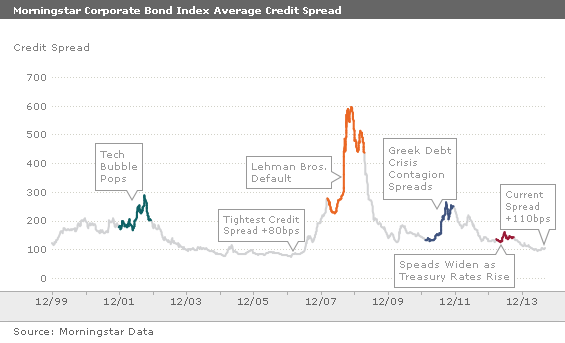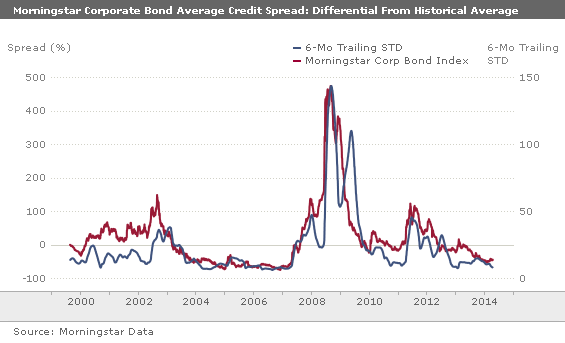The mudslinging continues Bond ETF liquidity crunch not looming proponents say
Post on: 9 Май, 2015 No Comment

Exchange-traded funds have dealt with their fair share of criticism over the years. Thats what having so much success tends to get you.
Now theyre being put on the spot for potentially leaving investors with the risk of a liquidity crunch when interest rates begin to rise. But proponents of the investment vehicle aren’t buying into the concern, saying corporate bond markets might end up being a problem, but not because of the ETFs that invest in them.
“The mudslinging continues, even though [ETFs] have repeatedly proven themselves as a very efficient structure — even through crisis,” said Tyler Mordy, co-CIO at Hahn Investments Stewards & Co.
It was revealed last week that the Financial Stability Board (FSB), a regulatory task force for the Group of 20 economies, is looking at certain ETFs that may not be able to fulfill their obligations in a rising rate environment.
The mudslinging continues, even though [ETFs] have repeatedly proven themselves as a very efficient structure — even through crisis
In particular, the FSB is said to be examining ETFs that invest in less liquid markets, such as those for high-yield corporate bonds, which have become a favourite of yield-hungry investors in recent years. The demand means they are possibly susceptible to a large-scale selloff in the event of higher rates.
Theres been investments and positions taken that may not have the liquidity there that people expect, especially as interest rates start to normalize, Carolyn Wilkins, senior deputy governor at the Bank of Canada and its representative at the FSB, told Bloomberg News on Sept. 23. So the liquidity illusion, if you want to put it that way, is something that were worried about.
Mr. Mordy, however, doesnt see it that way. He agrees that liquidity in the corporate bond is currently constrained, but said its a “red herring to blame ETFs.
“ETFs do not exacerbate liquidity issues, nor cause systemic risks, he said.
For example, the high-yield bond market came under substantial selling pressure and liquidity dried up during the height of the global financial crisis in September and October of 2008.
Mr. Mordy said the ETF industry’s authorized participants — the market makers responsible for maintaining a funds liquidity and ensuring the fund is trading in line with the underlying net asset value — recognized they would unlikely be able to sell the underlying basket of bonds and opted not to process redemptions.
As a result, they let the ETF trade at a temporary discount to net asset value while they waited for a recovery.
“Clearly, this is a favourable approach when compared to bond mutual funds, which would be forced to sell their underlying holdings into a market with extremely scarce buyers should investors request redemptions,” Mr. Mordy said.
A recent study by the Investment Company Institute, a national association of U.S. investment companies, including mutual funds, closed-end funds, ETFs and unit investment trusts, also supports the idea that ETFs have minimal impact on the underlying markets that they invest in.
Based on its analysis, the vast majority of ETFs do not have any primary market activity and, therefore, do not create or redeem shares that would require transactions to be made in the underlying securities.
Instead, investors make greater use of the secondary market of existing ETFs, so they do not create transactions in the underlying securities because only the ETF shares are trading hands.
On average, daily creations and redemptions represent 19% of total trading for bond ETFs and just 9% for equity ETFs, the ICI said.
The primary market is tapped more often for bond ETFs because many small bond ETFs tend to have less-established secondary markets, the association added, but the average daily creation and redemption of bond ETFs were just 0.34% of total net assets.
If rates were to rise dramatically and cause a selloff in corporate bond markets, exchange-traded funds will not be the catalyst, nor should they be the scapegoat for it, said Howard Atkinson, president of Horizons ETFs.
ETF investors will participate in the downside, just like all other investors in corporate bonds, and may even be less impacted than someone trying to shop an issue by themselves.

This is an important concept and if investors understand it, there should be no illusion of liquidity
He said the liquidity of the ETF market is influenced by three factors, including the trading volume of the funds, and any steps taken by the market maker, but at the most basic level, ETF liquidity is equal to the liquidity of the underlying securities.
If you are dealing with large-cap stocks, that is very liquid. If youre dealing in government treasury bonds, that is very liquid. But if you are dealing with high-yield bonds, thats not as liquid, and Mongolian equities, less liquid still, Mr. Atkinson said.
This is an important concept and if investors understand it, there should be no illusion of liquidity,’ he said.
That said, Mr. Atkinson doesnt believe the ETF market is nearly big enough to have an influence on corporate bond liquidity.
He pointed out that the U.S. corporate bond market is worth roughly US$9.7-trillion, while the overall bond ETF category south of the border — including those that track government issues — is worth US$245-billion, or just 3% of the corporate bond market.
In contrast, bond mutual funds in the U.S. are worth approximately US$1.7-trillion or 18% of the total corporate bond market.
To single out ETFs doesnt make much sense, given mutual funds are going to be impacted by the same liquidity or lack of liquidity of corporate bonds, Mr. Atkinson said.
Noel Archard, BlackRock Inc.s managing director in charge of Canadian operations, said theres little danger that ETF liquidity will dry up, even among those that invest in less fluid corporate bond markets.
Ive said this more times than I can count in my career, but you cant create liquidity out of illiquidity, he said. If theres not a liquid enough underlying market, you cant actually build an ETF in the first place. It just wont survive.














